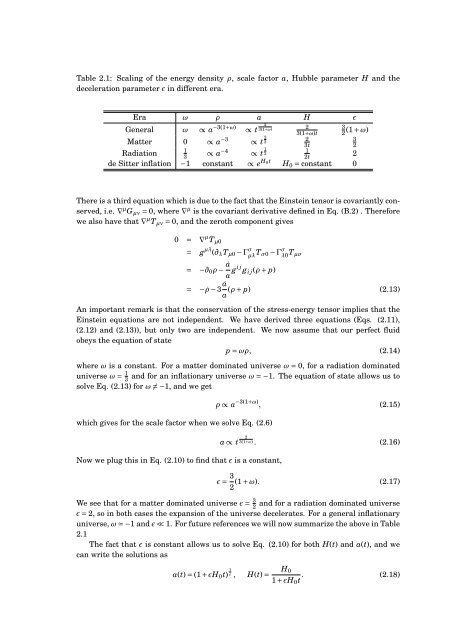Master's Thesis in Theoretical Physics - Universiteit Utrecht
Master's Thesis in Theoretical Physics - Universiteit Utrecht
Master's Thesis in Theoretical Physics - Universiteit Utrecht
Create successful ePaper yourself
Turn your PDF publications into a flip-book with our unique Google optimized e-Paper software.
Table 2.1: Scal<strong>in</strong>g of the energy density ρ, scale factor a, Hubble parameter H and thedeceleration parameter ɛ <strong>in</strong> different era.Era ω ρ a H ɛGeneral ω ∝ a −3(1+ω) ∝ t23(1+ω)23(1+ω)tMatter 0 ∝ a −3 ∝ t 2 321Radiation3∝ a −4 ∝ t 1 2de Sitter <strong>in</strong>flation −1 constant ∝ e H 0tH 0 = constant 032(1 + ω)323t12t2There is a third equation which is due to the fact that the E<strong>in</strong>ste<strong>in</strong> tensor is covariantly conserved,i.e. ∇ µ G µν = 0, where ∇ µ is the covariant derivative def<strong>in</strong>ed <strong>in</strong> Eq. (B.2) . Thereforewe also have that ∇ µ T µν = 0, and the zeroth component gives0 = ∇ µ T µ0= g µλ (∂ λ T µ0 − Γ σ µλ T σ0 − Γ σ λ0 T µσ= −∂ 0 ρ − ȧa gi j g i j (ρ + p)= − ˙ρ − 3 ȧ (ρ + p) (2.13)aAn important remark is that the conservation of the stress-energy tensor implies that theE<strong>in</strong>ste<strong>in</strong> equations are not <strong>in</strong>dependent. We have derived three equations (Eqs. (2.11),(2.12) and (2.13)), but only two are <strong>in</strong>dependent. We now assume that our perfect fluidobeys the equation of statep = ωρ, (2.14)where ω is a constant. For a matter dom<strong>in</strong>ated universe ω = 0, for a radiation dom<strong>in</strong>ateduniverse ω = 1 3and for an <strong>in</strong>flationary universe ω ≃ −1. The equation of state allows us tosolve Eq. (2.13) for ω ≠ −1, and we getwhich gives for the scale factor when we solve Eq. (2.6)Now we plug this <strong>in</strong> Eq. (2.10) to f<strong>in</strong>d that ɛ is a constant,ρ ∝ a −3(1+ω) , (2.15)2a ∝ t 3(1+ω) . (2.16)ɛ = 3 (1 + ω). (2.17)2We see that for a matter dom<strong>in</strong>ated universe ɛ = 3 2and for a radiation dom<strong>in</strong>ated universeɛ = 2, so <strong>in</strong> both cases the expansion of the universe decelerates. For a general <strong>in</strong>flationaryuniverse, ω ≃ −1 and ɛ ≪ 1. For future references we will now summarize the above <strong>in</strong> Table2.1The fact that ɛ is constant allows us to solve Eq. (2.10) for both H(t) and a(t), and wecan write the solutions asa(t) = (1 + ɛH 0 t) 1 ɛ , H(t) =H 01 + ɛH 0 t . (2.18)
















